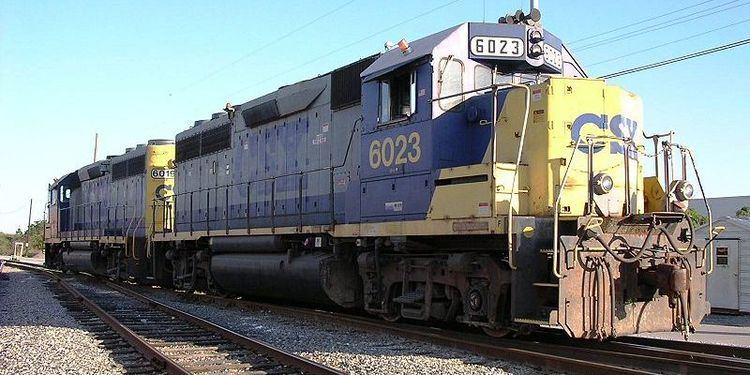Power type Diesel-electric Build date 1972 - 1986 AAR wheel arr. B-B | Model GP40-2 Total produced 1,143 | |
 | ||
Builder General Motors Electro-Motive DivisionGeneral Motors Diesel (GMD) | ||
The EMD GP40-2 is a 4-axle diesel road switcher locomotive built by General Motors Electro-Motive Division as part of its Dash 2 line between April 1972 and December 1986. The locomotive's power is provided by an EMD 645E3 16-cylinder engine which generates 3,000 horsepower (2.24 MW).
Contents
Production
Standard GP40-2 production totalled 861 units, with 817 built for U.S. railroads, and 44 for Mexican roads. In addition, three GP40P-2s, passenger versions of the GP40-2, were built for Southern Pacific in 1974, and 279 GP40-2L(W) and GP40-2(W) units, equipped with wide-nosed cabs, were built by General Motors Diesel (GMD), for Canadian National and GO Transit between 1974 and 1976. Of the CN units, 233 were built with a taller and lighter frame to allow for a larger fuel tank. These units were officially classified GP40-2L but are commonly referred to as GP40-2L(W). The balance of CN's fleet, 35 units, and the 11 unit GO Transit fleet, used standard frames and smaller fuel tanks; they are often referred to as GP40-2(W) but are classified as GP40-2. Total production of the GP40-2 and its variations totalled 1,143 units.
Although the GP40-2 was a sales success, it sold fewer units than the earlier GP40 and the contemporary GP38-2 and SD40-2 models. The popularity of high-horsepower 4-axle diesels began to decline with the GP40-2, with 6-axle models gaining in popularity for their superior low-speed lugging performance.
Performance
Like the SD40-2 the GP40-2 has a reputation for reliability, and many are still in use. Changes such as the modular electronics system improved reliability over the GP40. Their high power-per-axle rating suited them to high-speed service rather than low-speed drag freights.
With the usual 62:15 gearing (65-70 mph maximum) EMD rated the GP40-2 at 55,400 lb continuous tractive effort; for compatibility with other units, most (all?) had the PF21 module that reduced horsepower below 23 mph, bringing the minimum continuous speed down to 11 mph.
Spotting features
The GP40-2 car body retains the high "spartan" lines of other EMD locomotives of the same era, with a beveled nose and an angular, slant-roof cab. There are three large radiator fans at the rear of the hood and a single fan in the middle for the dynamic brakes (if equipped). The radiator intakes are smaller than those of the later GP50, and the walkways lack the end "porches" of the 6-axle SD40-2.
The GP40-2 can be distinguished from the earlier GP40 by the oval-shaped water-level sight glass at the right rear of the long hood; bolted (rather than hinged) battery boxes ahead of the cab; lengthened walkway blower duct; and various minor cosmetic differences in the front air intake and rear hood doors. A number of GP40-2s also came with the new Blomberg M-type trucks, with single-clasp brakes, rubber pads replacing the central leaf springs and a shock strut over each axle.
Phases
A number of minor changes were made to GP40-2s throughout their production run:
GP40M-2
The GP40M-2 is a loose designation, being used to cover both upgrades of pre-Dash 2 units to Dash 2 spec.
